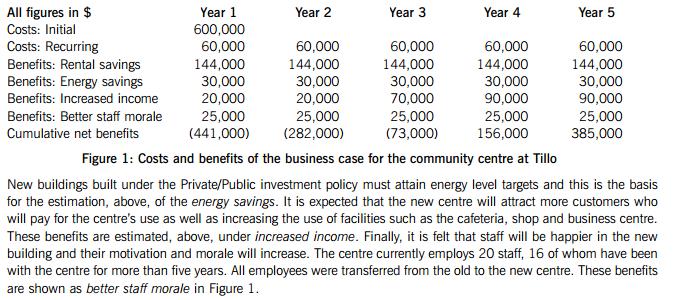7 [P.T.O.3 Introduction
The country of Mahem is in a long and deep economic recession with unemployment at its highest since the country
became an independent nation. In an attempt to stimulate the economy the government has launched a Private/Public
investment policy where the government invests in capital projects with the aim of stimulating the involvement of
private sector firms. The building of a new community centre in the industrial city of Tillo is an example of such an
initiative. Community centres are central to the culture of Mahem. They are designed as places where people can
meet socially, local organisations can hold conferences and meetings and farmers can sell their produce to the local
community. The centres are seen as contributing to a vibrant community life. The community centre in Tillo is in a
sprawling old building rented (at $12,000 per month) from a local landowner. The current community centre is also
relatively energy inefficient.
In 2010 a business case was put forward to build a new centre on local authority owned land on the outskirts of Tillo.
The costs and benefits of the business case are shown in Figure 1. As required by the Private/Public investment policy
the project showed payback during year four of the investment.

Construction of the centre 2010–2011
In October 2010 the centre was commissioned with a planned delivery date of June 2011 at a cost of $600,000 (as
per Figure 1). Building the centre went relatively smoothly. Progress was monitored and issues resolved in monthly
meetings between the company constructing the centre and representatives of the local authority. These meetings
focused on the building of the centre, monitoring progress and resolving issues. Most of these issues were relatively
minor because requirements were well specified in standard architectural drawings originally agreed between the
project sponsor and the company constructing the centre. Unfortunately, the original project sponsor (an employee of
the local authority) who had been heavily involved in the initial design, suffered ill health and died in April 2011. The
new project sponsor (again an employee of the local authority) was less enthusiastic about the project and began to
raise a number of objections. Her first concern was that the construction company had used sub-contracted labour
and had sourced less than 80% of timber used in the building from sustainable resources. She pointed out the
contractual terms of supply for the Private/Public policy investment initiatives mandated that sub-contracting was not
allowed without the local authority’s permission and that at least 80% of the timber used must come from sustainable
forests. The company said that this had not been brought to their attention at the start of the project. However, they
would try to comply with these requirements for the rest of the contract. The new sponsor also refused to sign off
acceptance of the centre because of the poor quality of the internal paintwork. The construction company explained
that this was the intended finish quality of the centre and had been agreed with the previous sponsor. They produced
a letter to verify this. However, the letter was not counter-signed by the sponsor and so its validity was questioned. In
the end, the construction company agreed to improve the internal painting at their own cost. The new sponsor felt
that she had delivered ‘value for money’ by challenging the construction company. Despite this problem with the
internal painting, the centre was finished in May 2011 at a cost of $600,000. The centre also included disability
access built at the initiative of the construction company. It had found it difficult to find local authority staff willing
and able to discuss disability access and so it was therefore left alone to interpret relevant legal requirements.
Fortunately, their interpretation was correct and the new centre was deemed, by an independent assessor, to meet
accessibility requirements.
8Unfortunately, the new centre was not as successful as had been predicted, with income in the first year well below
expectations. The project sponsor began to be increasingly critical of the builders of the centre and questioned the
whole value of the project. She was openly sceptical of the project to her fellow local authority employees. She
suggested that the project to build a cost-effective centre had failed and called for an inquiry into the performance of
the project manager of the construction company who was responsible for building the centre. ‘We need him to explain
to us why the centre is not delivering the benefits we expected’, she explained.
Required:
(a) The local authority has commissioned the independent Project Audit Agency (PAA) to look into how the project
had been commissioned and managed. The PAA believes that a formal ‘terms of reference’ or ‘project initiation
document’ would have resolved or clarified some of the problems and issues encountered in the project. It also
feels that there are important lessons to be learnt by both the local authority and the construction company.
Analyse how a formal ‘terms of reference’ (project initiation document) would have helped address problems
encountered in the project to construct the community centre and lead to improved project management in
future projects. (13 marks)
(b) The PAA also believes that the four sets of benefits identified in the original business case (rental savings, energy
savings, increased income and better staff morale) should have been justified more explicitly.
Draft an analysis for the PAA that formally categorises and critically evaluates each of the four sets of
proposed benefits defined in the original business case. (12 marks)
(25 marks)